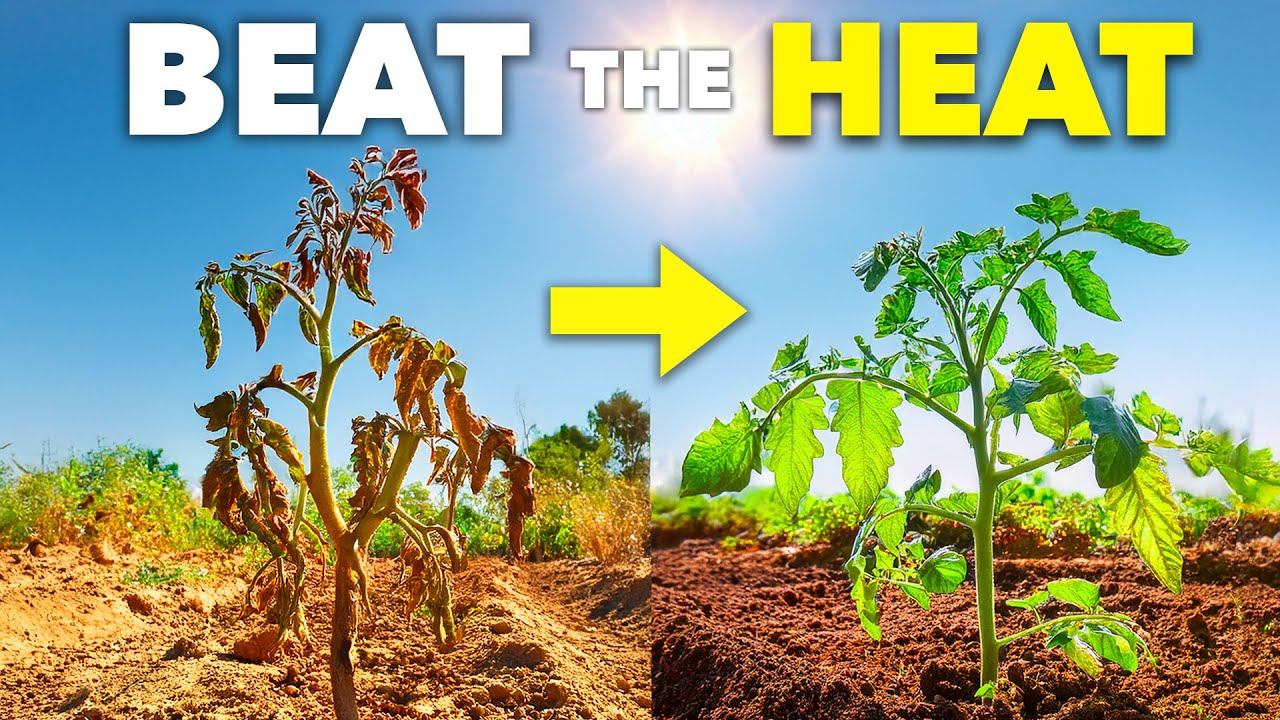Are you worried about how a heatwave might affect your garden? Discover the top strategies that smart gardeners use to stay ahead of the heat and protect their plants. With these effective tips, you can ensure your garden remains healthy and thriving—even during the hottest days.
Introduction
Imagine a garden shivering in the sizzling spotlight of an impending heatwave—the leaves drooping, the flowers wilting, and the wild optimism of spring giving way to a desperate plea for mercy. It’s a familiar scene for those who adore their outdoor sanctuaries but know all too well the silent menace lurking just beyond the weather forecast’s confident forecast. Preparing your garden for upcoming heatwaves isn’t just a matter of turning on the sprinkler and crossing your fingers; it’s a strategic dance, a subtle art form that combines science, intuition, and a dash of good old-fashioned elbow grease.
In the world of smart gardening, the focus shifts from reactive watering to proactive planning. From selecting heat-tolerant plants that laugh in the face of soaring temperatures to designing a layout that maximizes shade—each move is a calculated step toward resilience. Grab your sunhat, and let’s delve into the effective strategies savvy gardeners use to keep their botanical pride and joy flourishing in the face of nature’s fiery challenge. After all, a well-prepared garden isn’t just a display of beauty; it’s a testament to your patience, wit, and ability to outsmart the summer sun.
How to Prepare Your Garden for Upcoming Heatwaves to Keep Your Plants Cool
The moment you sense those summer scorchers on the horizon, it’s time to roll up your sleeves and employ some clever tactics that turn heat into a manageable guest rather than an unruly hothead. Preparation begins underground—literally—with soil that’s enriched, mulched, and capable of holding moisture like a sponge drying in the dew. Think of it as giving your plants a cozy blanket that retains water longer, so they don’t have to beg for hydration every hour. Mulches, especially organic ones like straw or bark chips, act as magic carpets—cooling the roots and shielding them from the sun’s relentless gaze.
Next, it’s about shielding your greenery with shade solutions that are both functional and aesthetically pleasing. Shade cloths, when stretched carefully over vulnerable saplings, create a cool canopy that reduces heat stress without turning your backyard into a cave. It’s an elegant dance between practicality and artistry—letting just enough sunlight through so photosynthesis still fosters growth while blocking out dangerous doses of UV radiation. Pair this with a strategic placement of taller plants or lightweight structures, and suddenly, you’ve transformed your garden into a summer sanctuary rather than a desert.
Finally, don’t forget the power of microclimates—those tiny natural nooks built by the contours of your garden, potted arrangements, or even trellises. By understanding and enhancing these natural refuges, you can give your plants a fighting chance against the heat. Create a cool corner with strategically placed stones or planters, and watch how your garden adapts, offering respite against the blistering days ahead. Preparation is all about thinking ahead, planning smart, and cultivating a resilient environment that whispers, “Bring it on, summer.”
Follow Expert Tips on How to Select Heat-Tolerant Plants
Choosing the right plant can make all the difference in a heatwave. It’s no longer just about aesthetic preferences; it’s about survival skills. Expert gardeners recommend opting for native or drought-resistant species that have evolved to thrive where water is scarce and temperatures hit unbearable heights. These hardy contenders—such as succulents, lavender, or ornamental grasses—swallow the heat like a refreshing sip of water. They’ve got thick leaves, waxy coatings, or deep roots that tap into underground moisture, and that makes all the difference when the thermometer climbs past comfort levels.
The secret isn’t just in picking the obvious tough guys but in understanding their needs and deficiencies. Some plants may be touted as drought-tolerant but still require specific soil conditions or partial shade. A wise gardener consults local extension services, online plant databases, or even takes a stroll through neighbor’s gardens to discover which species are thriving despite the punishing sun. Instead of fighting nature, these choices work with it—allowing your garden to flourish without constant babysitting, even amid extreme heat.
Moreover, integrating drought-resistant plants into your garden plan creates a harmonious, sustainable landscape that can endure future heatwaves. These plants often serve as the backbone of a resilient garden, providing color, texture, and structure without the water-guzzling guilt. Think of it as planting for the future—an eco-friendly, water-wise strategy that keeps your outdoor space vibrant while conserving resources. Expert advice reminds us that wise plant choices aren’t just about aesthetics but vital tools for weathering the fiery days ahead.
Water Your Garden Efficiently to Conserve Water During Hot Weather
When the temperatures soar, simply turning on the hose isn’t enough—it’s about precision, patience, and a little bit of detective work. Water efficiency becomes the gardener’s best friend during hot spells, not only conserving precious resources but also ensuring plants get what they need without drowning in excess. Early mornings and late evenings are prime watering windows, when the sun’s rays are gentle and evaporation is kept to a minimum. It’s like giving your plants a private cocktail party—cozy, cool, and tailor-made for their needs.
To truly master water conservation, consider drip irrigation systems or soaker hoses that deliver water directly to the root zone, where it’s needed most. This targeted approach minimizes waste and prevents weeds from stealing moisture. Think of it as your garden’s own version of a VIP treatment—exclusive and efficient. Watching the water-saving ideas video can reveal practical tips like adjusting sprinkler heads to avoid runoff or using mulch layers to suppress evaporation. Your garden becomes not just a beautiful space but a lesson in sustainability—picture that, a garden that thrives without wasting a single precious drop.
Further, it’s wise to plan your watering schedule well in advance, setting timers that adapt to the changing heat. The goal isn’t just to quench thirst once in a while but to maintain a consistent moisture level that keeps plants healthy and resilient. Combining this strategy with drought-tolerant plant choices and shadier spots can stretch your gardening efforts further and keep your landscape lush and thriving despite the scorching threat.
Frequently Asked Questions
Q1: How do I choose the best shade cloths for my garden during a heatwave?
A1: Selecting the right shade cloth involves understanding your garden’s specific needs—consider the amount of sunlight your plants receive and how much shading they require. Look for fabrics with the appropriate UV protection level, typically indicated by a percentage, such as 40% or 60%. For delicate plants, a lighter shade that still filters out harsh rays is ideal, while more robust species may tolerate or even benefit from heavier shading. Proper installation—stretched tightly over sturdy frames or structures—ensures even coverage and maximum cooling effect.
Q2: Are there native plants especially suited for hot, dry climates?
A2: Absolutely. Native plants are practically pre-programmed to handle extreme winter and summer conditions—they’re the natural survivors. Think of species like desert marigold, yucca, or black-eyed Susan; these hardy standouts drink in the sun and refuse to wilt under pressure. Integrating these into your garden doesn’t just boost resilience but also supports local ecosystems, attracting native pollinators and supporting biodiversity.
Q3: What are some effective DIY watering techniques I can implement without fancy equipment?
A3: You can get crafty with simple tools—using old containers or bottles pierced with tiny holes, buried next to your plants for slow, steady watering. Creating a mini rain barrel from a clean trash can can also serve as a budget-friendly source of stored rainwater. Elevate your watering can or bucket on a small platform to create gravity-fed flow, or use a stiff brush to clean and maintain hoses and nozzles for efficient water flow. Thoughtful, intentional watering techniques can make a significant difference.
Q4: How can I improve my garden’s microclimate to beat the heat?
A4: Enhancing your garden’s microclimate is a matter of creating natural cooling zones. Place rocks or concrete blocks in shaded areas to absorb and radiate heat away from plants during the night. Use taller plants or trellises to cast shadows over sensitive beds during peak sun hours. Grouping plants with similar water and sunlight needs reduces watering stress, and installing small fountains or misting systems adds humidity and lowers ambient temperatures, turning your garden into a refreshing oasis.
Q5: Is it a good idea to prune plants before a heatwave?
A5: Yes—and no. Light pruning to remove dead or diseased leaves can reduce transpiration and help plants conserve water. However, heavy pruning just before a heatwave can weaken a plant’s structural integrity and expose new growth to damage. Aim for a balanced approach—trim strategically to improve airflow and remove vulnerable parts but avoid over-pruning, allowing your plants to maintain their natural defenses and resilience against the scorching days ahead.
Final Thoughts
There’s an elegance in embracing the challenge of a heatwave, a kind of garden alchemy that transforms anxiety into action. Smart gardeners aren’t just reactive—they’re anticipatory, inventive, and, dare I say, a little bit daring. They understand that the secret to thriving under the hot sun isn’t merely about watering more but about planning, protecting, and harmonizing with nature’s rhythms. As you stand in your garden, with the sun casting long afternoon shadows and the scent of mulch in the air, remember: resilience isn’t born from brute force but from thoughtful preparation and a willingness to adapt. When next summer’s heatwave hits, your garden will be a testament to your wit and foresight—proving that with a little planning, even the fiercest days can be faced with confidence.

